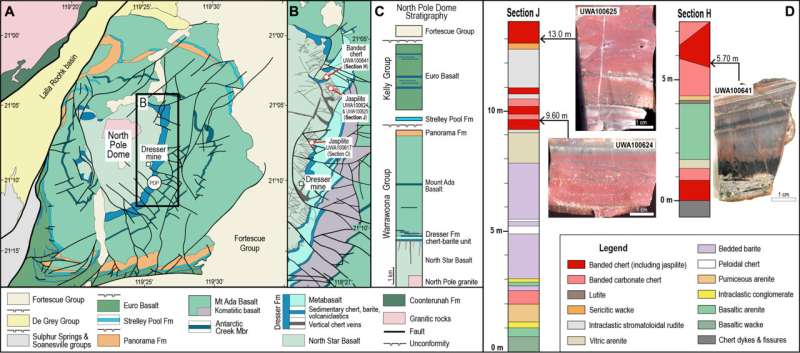This article has been reviewed according to Science X's editorial process and policies. Editors have highlighted the following attributes while ensuring the content's credibility:
fact-checked
peer-reviewed publication
trusted source
proofread
3.5 billion-year-old hydrothermal vent sediments offers clues to life's origin

Researchers from The University of Western Australia examined 3.5 billion-year-old hydrothermal vent sediments and discovered clues about the origin and early evolution of life.
The study, by Professor Birger Rasmussen and Dr. Janet Muhling, from UWA's School of Earth Sciences, and Professor Nicholas Tosca, from the Department of Earth Science at University of Cambridge, was published in the journal Science Advances.
They examined 3.5 billion-year-old jaspers from the North Pole Dome area west of Marble Bar in the Pilbara region of Western Australia and found it contained abundant particles of iron-rich clay, identified as greenalite.
"We discovered the tiny clay particles were much more abundant than the prominent iron-oxide particles that give the jaspers their bright red color," Professor Rasmussen said.
"The tiny, drab greenalite particles are essentially hidden in plain sight and are only observable using very high magnification electron microscopes."
Geochemical modeling by Professor Tosca predicted greenalite was the main iron-rich mineral to form when hot vent fluids mixed with seawater on early Earth.
The researchers also found tiny particles of apatite, a calcium phosphate mineral, with the clay particles.
Professor Tosca's modeling of seawater circulation through the oceanic crust beneath the ancient seafloor indicates the phosphorus was released into vent fluids as minerals in the crust reacted with the heated seawater.
"This suggests seafloor vent systems may have been a source of phosphorus for life on early Earth," Professor Rasmussen said.
"Because the minute apatite particles did not dissolve in seawater, we estimate that seawater phosphorus concentrations were likely 10 to 100 times higher than in today's deep ocean."
The study suggests hydrothermal vents, which probably littered the seafloor soon after the first oceans formed about 4.2 billion years ago, were not only a source of phosphorus, essential for the origin and early evolution of life, but also produced trillions upon trillions of tiny, highly reactive clay particles.
More information: Birger Rasmussen et al, Nanoparticulate apatite and greenalite in oldest, well-preserved hydrothermal vent precipitates, Science Advances (2024). DOI: 10.1126/sciadv.adj4789
Journal information: Science Advances
Provided by University of Western Australia





















